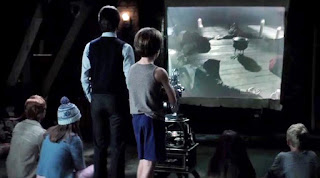·
The first feeling of “Wait, what day is it?”
when I woke up.
SHUT IN is a revenge drama
about an agoraphobic woman beset by three home invaders. But then… Again, going
into a film knowing next-to-nothing means the pleasures of the twists are a joy
for being unexpected and this isn’t quite as expected. Sleek, a little mean,
high concept and greatly entertaining, it also boasts fine performance all
round.
BAIT is an English drama about
a couple of women trying to get ahead in the world and being victimised by a
sadistic loan shark. Good performances bring out the most of the script,
despite an undercurrent of Brit-crime shouty crime dramatics. Despite plot
holes (are the police completely unaware when there is plenty of evidence and
devastation lying around?) this is an engaging revenge drama (again). Since
this is all an allegory for the way people are exploited by unscrupulous
others, including banks, the audience is ecstatic when the girls get their own
back. Turning-the-tables seems to be a sure-fire crowd-pleaser.
FRANKENSTEIN updated by
Bernard Rose and moved to Los Angeles. Rose’s concentration on the monster is
closer to the novel than most, although he is less verbally articulate, and
removing all the pleasurable Gothic tropes leaves a starkness to the story of
humanising a monster and no less affecting. I suspect time will tell this
version’s true stature but it’s certainly a successful modernisation, with –
again – good performances.
SOME KIND OF HATE will be the
first of two films concentrating on hard rock/metal fans and their alienation.
Finally fighting back on the bullies only gets Lincoln into a reform school in
the middle of the desert where old patterns only manifest themselves again,
driving him to the attention of a vengeful spirit. The pacing and editing
really stick out, minimising scenes you might have thought would be more
central and longer whilst keeping it all speeding along. It also blithely
eschews jump-scares to get to harsher truths. In Moira, the vengeful spirit who
attacks her victims by self-harming, the film truly taps into something about bullying
and its effects without ignoring masochism or brutality on all sides.
RABID DOGS is not horror at
all, but rather a violent heist thriller that is often as sleek as a commercial
and twisty enough not to be thoroughly predictable. The heist goes a bit wayward
and most of the film is taken up with the robbers and their hostages in a car,
until they seem to stop into an aggressively jovial small village holding a
Bear festival. It’s like a gangster thriller gate-crashed a Wicker Man scenario.
There are probably goingf to be twists you don’t see coming. Thoroughly
enjoyable.
DEATHGASM was one I thought
was not going to do much for me, trading in to the Heavy Metal angle of Horror.
Then I realised that I was stupid to take the title as anything else but a cue
for an affectionate homage to the absurdities of the genre. This is the second film
today where a Metal-loving protagonist gets revenge, but this time he literally
unleashes Hell on Earth by using power chords. Jackson’s “Brain Dead” has to be
a reference but it mostly keeps to gags coming until the very end. Gory, gross,
funny.





















